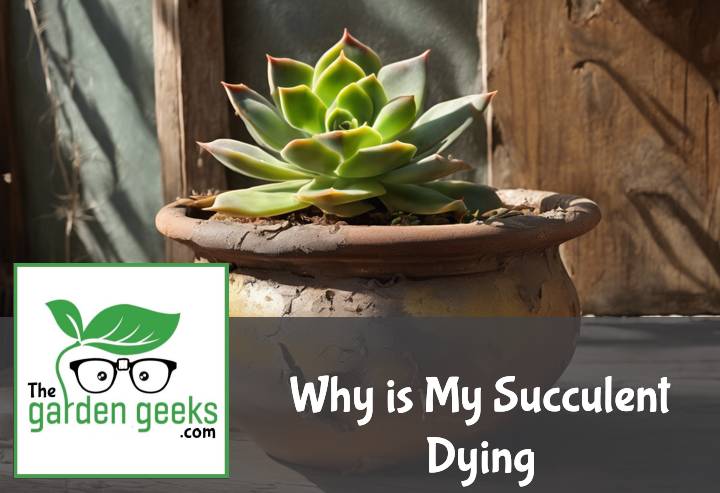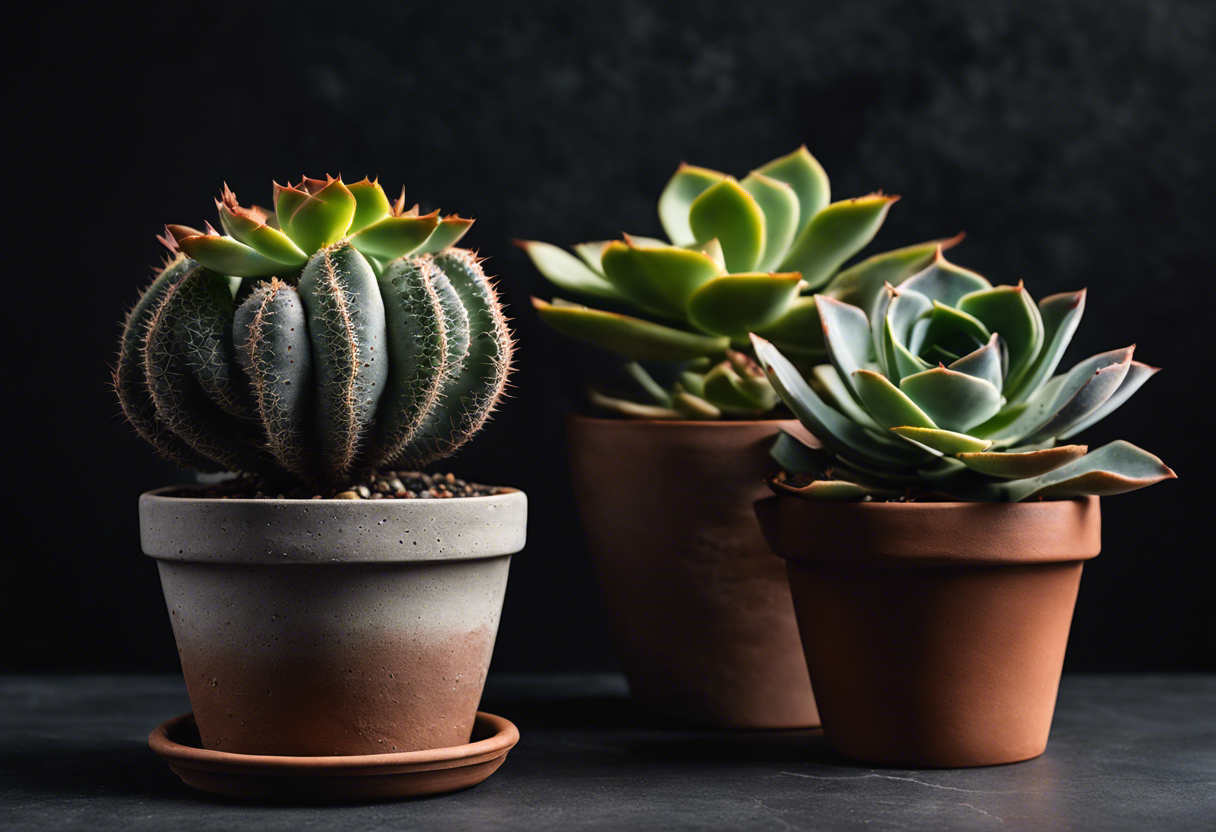Ever looked at your once vibrant, plump succulent only to find it looking a little sad and thought, “Why is My Succulent Dying“:https://en.wikipedia.org/wiki/Succulent_plant? Trust me, I’ve been there. It’s like watching your favorite sitcom character being written off the show – heartbreaking!
But don’t pull out the funeral dirge just yet! We’ve got some simple solutions that can help nurse your plant back to health. So keep reading about ‘Why is My Succulent Dying? (6 Solutions that Actually Work)’.
Key Takeaways
- Your succulent may be dying due to overwatering or underwatering, poor lighting conditions, temperature stress, incorrect soil type, pest infestation or disease.
- Overwatering can cause root rot; water only when the soil is completely dry.
- Provide enough light but avoid direct sunlight which can cause sunburn.
- Maintain a temperature between 55-80°F and avoid sudden changes.
- Use well-draining soil to prevent waterlogging.
- Regularly check for pests and diseases and treat them promptly.
Understanding Succulents
Succulents, oh succulents! These quirky little plants have taken the world by storm. But why is my succulent dying? Well, let’s start from the beginning.
What are Succulents?
Succulents are a group of plants known for their water-storing abilities. They’re like the camels of the plant world. Their leaves, stems or roots can store water, allowing them to survive in arid conditions where other plants would shrivel up and die.
They come in all shapes and sizes, from tiny little ones that fit in the palm of your hand to big ones that can grow several feet tall. And let’s not forget about their wide range of colors! From vibrant greens to deep purples, there’s a succulent for every aesthetic.
These unique characteristics make them popular houseplants. Plus, they’re pretty low maintenance compared to other indoor plants which makes them perfect for those who lack a green thumb but still want some greenery around.
The Ideal Environment for Succulents
Now that we know what succulents are, let’s talk about where they thrive best. Despite being desert dwellers by nature, they don’t necessarily need scorching heat and dry air to survive.
Light is crucial for these sun-loving beauties. A spot near a south-facing window is ideal for indoor succulents as it provides plenty of bright but indirect light. Too much direct sunlight can cause their leaves to scorch while too little light can lead to etiolation (that’s fancy plant talk for when they stretch out looking for more light).
Temperature-wise, most types of succulent plants prefer a mild climate – not too hot and not too cold. Think Goldilocks temperatures: just right!
Humidity levels also play a role in succulent plant care. While they can tolerate dry air, they don’t do well in overly humid conditions. So if you live in a place that’s more rainforest than desert, you might want to consider getting a dehumidifier or choosing succulents that are better adapted to high humidity environments.
Remember, every succulent is unique and may have slightly different care requirements. But by understanding these general guidelines, you’re one step closer to figuring out why your succulent is dying and how to bring it back to life!
Common Reasons Why Your Succulent is Dying
Ever wondered, “Why is My Succulent Dying?” Well, succulent care mistakes are often the culprits. From watering issues to light conditions, soil quality to temperature stress, and pests/diseases – these common succulent problems can lead to a dying succulent.
Overwatering or Underwatering
Overwatering and underwatering – both are like kryptonite for your little green friend. Signs of overwatered succulents include mushy leaves and stem rot. On the flip side, underwatered buddies show wrinkled leaves and dry soil. The trick to watering succulents correctly? Let the soil dry out completely between waterings.
Incorrect Light Conditions
Just like Goldilocks, succulents need their light “just right”. Too much sunlight can scorch them while insufficient light makes them leggy. Each type has its own succulent light requirements, so it’s crucial to know yours well. If you notice any adverse effects, it’s time for some shade or a sunny spot!
Poor Soil Quality
Poor soil quality can be another nail in the coffin for your plant buddy. Succulents prefer well-draining soil that mimics their natural arid habitats. If your plant looks unhappy, consider switching to the best soil for succulents available in the market.
Temperature Stress
Succulents are desert plants but they don’t all appreciate extreme heat or cold! Temperature stress can cause wilting or color changes in your plant. Most varieties prefer temperatures between 60-80°F (15-27°C). If you notice any signs of temperature stress, adjust your plant’s environment accordingly.
Pests and Diseases
Last but not least, pests and diseases can wreak havoc on your green friends. Mealybugs, scale, and fungal diseases are common culprits. If you spot any signs of these common succulent pests or diseases, it’s time to roll up your sleeves and start the rescue mission!
6 Solutions to Revive Your Dying Succulent
If you’re asking yourself, “Why is My Succulent Dying?“, don’t fret. Here are six succulent care solutions that will help you revive your dying succulent.
Adjusting Watering Habits
First off, let’s talk about water. Overwatering or underwatering can turn your green thumb blue real quick. So, how do you find the optimal watering for succulents?
Well, it’s all about balance. Too much water and your succulent might drown. Too little and it’ll shrivel up faster than a raisin in the sun. The key is to keep the soil moist but not soggy.
Remember, these plants are desert dwellers—they’re used to a little dry spell now and then. So, when in doubt, hold off on the H2O.
Modifying Light Exposure
Next up: light exposure. Like Goldilocks’ porridge, it needs to be just right—not too much, not too little.
Too much sunlight can scorch your succulent faster than a vampire at dawn! On the other hand, insufficient light will leave it looking pale and sickly.
So what’s the solution? Well, if you’re growing them indoors, try to manage indoor lighting for succulents by placing them near a window where they can get plenty of indirect sunlight.
Improving Soil Quality
Poor soil quality is another common culprit behind a withering succulent. If your plant’s home feels more like quicksand than fertile ground, it might be time for an upgrade.
The best soil mix for succulents should be well-draining yet able to retain enough moisture for the roots to absorb. Adding some perlite or coarse sand into your potting mix could do wonders!
Regulating Temperature Conditions
Extreme temperatures are a no-go for succulents. These plants prefer a steady, mild climate—think room temperature.
To protect succulents from extreme temperatures, keep them away from drafty windows in winter and out of direct sunlight in summer. And remember, if you’re uncomfortable with the temperature, chances are your succulent is too.
Treating Pests and Diseases
Pests and diseases can turn your succulent into a zombie plant before you know it. If you spot any signs of infestation or illness, act fast!
There are plenty of ways to treat succulent pests and cure succulent diseases. From insecticidal soaps to neem oil sprays, there’s a solution for every problem.
Repotting the Succulent
Last but not least, repotting can be a game-changer when it comes to reviving your dying plant. It’s like moving your succulent into a new, healthier home!
The key here is knowing when to repot succulents. If the roots are overcrowded or the soil has degraded, it might be time for a change of scenery. Just make sure to handle with care during the move!
To Wrap Up
So, you’ve been wondering, “Why is My Succulent Dying?” Well, just like a toddler who’s had too much candy, your succulent might be suffering from overwatering or not enough sunlight. It’s all about finding that sweet spot!
Remember, your succulent isn’t a goldfish – it doesn’t need constant attention. Just the right amount of care and love will have it bouncing back in no time. Happy gardening!





